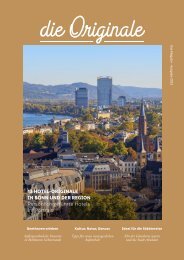LUXAIR_LUXiClub_So12 ls
p o
p
o
Create successful ePaper yourself
Turn your PDF publications into a flip-book with our unique Google optimized e-Paper software.
Number 43, Fall 2002
cartographic perspectives 45
information relatively effortlessly without explanation (such as text and
legends), so they can spend more of their limited time extracting essential
information and examining spatial relationships.
Maps designed in a cartographically realistic manner also have the
potential to be more attractive, even beautiful, compared to their conventional
counterparts. This is not a frivolous concern when trying to connect
with audiences. In this media-driven age of short attention spans, it is
important that we design maps that attract and hold a reader’s attention.
People purchase expensive cars based solely on color, vote for telegenic
political candidates, and invest substantial sums in corporations that publish
slick annual reports. Are map users any less susceptible to the allure
of attractive packaging?
Finally, making realistic NPS maps is a personal interest. Today, for
the first time cartographers have the tools and data available to push the
limits of map design with relative ease. Using new technology and data to
design better maps for park visitors is, for me, irresistible.
Cartographically realistic map design is not by any means new to cartography.
Among the most spectacular and enduring efforts in cartographic
realism are those made by 20 th century artist/cartographers.
“People purchase expensive cars
based solely on color, vote for
telegenic political candidates,
and invest substantial sums in
corporations that publish slick
annual reports. Are map users
any less susceptible to the allure
of attractive packaging?”
LOOKING BACK
Artist/cartographers
In the 1950s Hal Shelton, an employee of the USGS and an accomplished
fine artist, painted small-scale plan maps of the US to be used by air
travelers for general orientation. Shelton’s maps were unique in that they
portrayed land cover—forest, agricultural land, and built-up areas—in
combination with shaded relief to mimic what passengers would actually
see on the ground from an aircraft. On Shelton’s maps land cover was
portrayed more prominently than the terrain. Many of Shelton’s original
pieces, still under copyright protection, are housed at the US Library of
Congress where they may be viewed by appointment only.
Meanwhile, on the other side of the Atlantic, Eduard Imhof’s painted
map of Walensee, Switzerland is perhaps the most famous example of
early cartographic realism ever produced (Figure 2). Imhof’s piece is
noteworthy for its artistic use of strong colors to model topography,
which is combined with less dominant land cover. Deep reds are used
at higher elevations to give mountain peaks visual loft, blue-gray haze
suppresses the lowlands, and cast shadows thrown by steep mountains
extend onto the aqua green surface of Walensee. Holding true to the
Swiss cartographic preference, cliffs receive considerable textural detail
while agricultural fields and forests are depicted with flat color. Drainages
and light colored roads are slightly incised into the landscape, as a
viewer would expect them to be when viewed from above.
The Walensee map was painted experimentally to showcase the
unrestrained application of art in the cartographic context. The resulting
masterpiece is on permanent display at the Swiss Alpine Museum in
Berne. However, despite the accolades, Imhof was opposed to the idea
that his Walensee map would serve as a model for general cartographic
design.
“The Walensee map was
painted experimentally to
showcase the unrestrained
application of art in the
cartographic context.”
According to Imhof
“What is achieved by such painting experiments? When successful,
beautiful impressions, natural plan-view landscape pictures result—
the pictures that please the hearts of many viewers. But the end result















